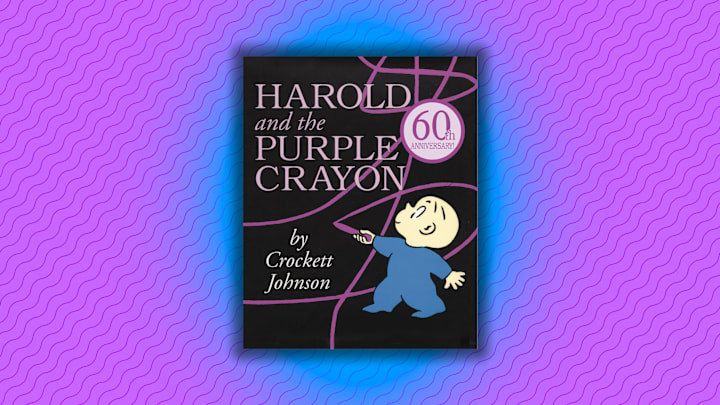The best children’s books communicate bigger ideas about the world in the guise of something frivolous. Few have done it better than Harold and the Purple Crayon, author Crockett Johnson’s 1955 illustrated book that marries concepts of philosophy with fantasy. The Harold of the title is a child who goes for a moonlit stroll without a moon—he can create his own reality with a giant purple crayon. When trouble arises, like a dragon, Harold can draw his way out of it. At the end, he’s safely in his own bed. Younger kids enjoy the fantastical elements; as they get older, the book’s musings on the nature of reality become more pronounced. A movie based on the book hits theaters August 2; to find out more about Harold and the Purple Crayon (including its connection to Sharon Stone), keep reading.
- Author Crockett Johnson was originally a comic strip artist.
- Harold and the Purple Crayon got a cool reception from Crockett’s editor.
- Maurice Sendak was more than just a fan of Harold and the Purple Crayon.
- Harold became the star of his own series.
- One edition of Harold and the Purple Crayon came with a purple crayon.
- The FBI liked to keep tabs on Johnson.
- Harold and The Purple Crayon has been adapted in different mediums, including one involving Sharon Stone.
Author Crockett Johnson was originally a comic strip artist.
The man born David Johnson Leisk on October 20, 1906, who later became famous under his pen name of Crockett Johnson—Crockett being his childhood nickname—first garnered attention for a comic strip. After studying art at Cooper Union and New York University, Johnson took on a series of odd jobs (including working at an ice plant and even playing pro football) before debuting in newspapers in 1942 with Barnaby. The strip featured a tyke named Barnaby Baxter who went on adventures with his “Fairy Godfather,” Mr. O’Malley, who went unseen by other characters. Johnson stopped writing the strip in 1946 but remained on as a story consultant before returning to write and draw the final strip in 1952. That was the same year Johnson published his first children’s book, Who’s Upside Down?
Harold and the Purple Crayon got a cool reception from Crockett’s editor.
When Johnson submitted the manuscript to Harold and the Purple Crayon to Harper & Row children’s book editor Ursula Nordstrom, her reaction was tepid. When she wrote back to Johnson in 1954, she attempted to couch the criticism in kindness and said:
“Dear Dave: The dummy [copy] of Harold and the Purple Crayon came this morning, and I've just read it. I don't know what to say about it. It doesn't seem to be a good children's book to me but I'm often wrong—and this post-Children's Book Week Monday finds me dead in the head. I'd probably pass up Tom Sawyer today. Let me keep the dummy a few days, will you?”
Nordstrom later changed her mind and came to agree with audiences. Harold and the Purple Crayon was a success upon its release in 1955 and hasn’t been out of print since.
Maurice Sendak was more than just a fan of Harold and the Purple Crayon.
Famed Where the Wild Things Are author Maurice Sendak had long championed Harold and the Purple Crayon, but it wasn’t strictly because he loved the book. Sendak actually apprenticed as an artist under Johnson, even spending weekends with Johnson and wife Ruth Krauss at their home on Long Island Sound in the 1950s. Sendak collaborated with Krauss for several of her books before striking out on his own.
Harold became the star of his own series.
The success of Harold and the Purple Crayon led Johnson to make Harold a recurring character. He ultimately appeared in seven of Johnson’s titles, including Harold’s Fairy Tale (1956), Harold’s Trip to the Sky (1957), Harold at the North Pole (1958), Harold’s Circus (1959), A Picture for Harold’s Room (1960), and Harold’s ABC (1963).
One edition of Harold and the Purple Crayon came with a purple crayon.
In the 1960s, Scholastic issued a version of Harold and the Purple Crayon that was a combination book-and-record set. (The record was an audio version of the book with music.) Inside the package was a nice bonus for readers: a purple crayon.
The FBI liked to keep tabs on Johnson.
Johnson, who died in 1975, didn’t lead the low-key life common to a lot of artists. Both he and Krauss were the subjects of FBI monitoring in the 1950s thanks to their personal politics. Johnson had been art editor of the Communist publication The New Masses, and though he never publicly aligned himself with Communism, the FBI maintained a file on him and considered him a subversive character. Despite their suspicions, he was never formally confronted with their allegations.
Harold and The Purple Crayon has been adapted in different mediums, including one involving Sharon Stone.
Three of the Harold books were adapted as short animated films, including Harold and the Purple Crayon (1959), A Picture for Harold’s Room (1971), and Harold’s Fairy Tale (1974). The films were later collected into a VHS release in 1993. HBO also produced a 13-episode animated series in 2001 that was narrated by actress Sharon Stone (Basic Instinct). Both Spike Jonze and Steven Spielberg wanted to adapt the book into a film; ultimately, Carlos Saldanha (Ice Age) ended up helming the live-action film that hits theaters in August 2024.
“When the opportunity came up to bring it to the big screen, the story felt like a reflection of my own journey, as both Harold and I are making the leap from animation to live-action,” the director told Publishers Weekly. Actor Zachary Levi playing the titular character, and Zooey Deschanel—who has called Harold “one of my favorite children’s books”—co-stars.
Read More About Children’s Books:
A version of this story ran in 2021; it has been updated for 2024.
